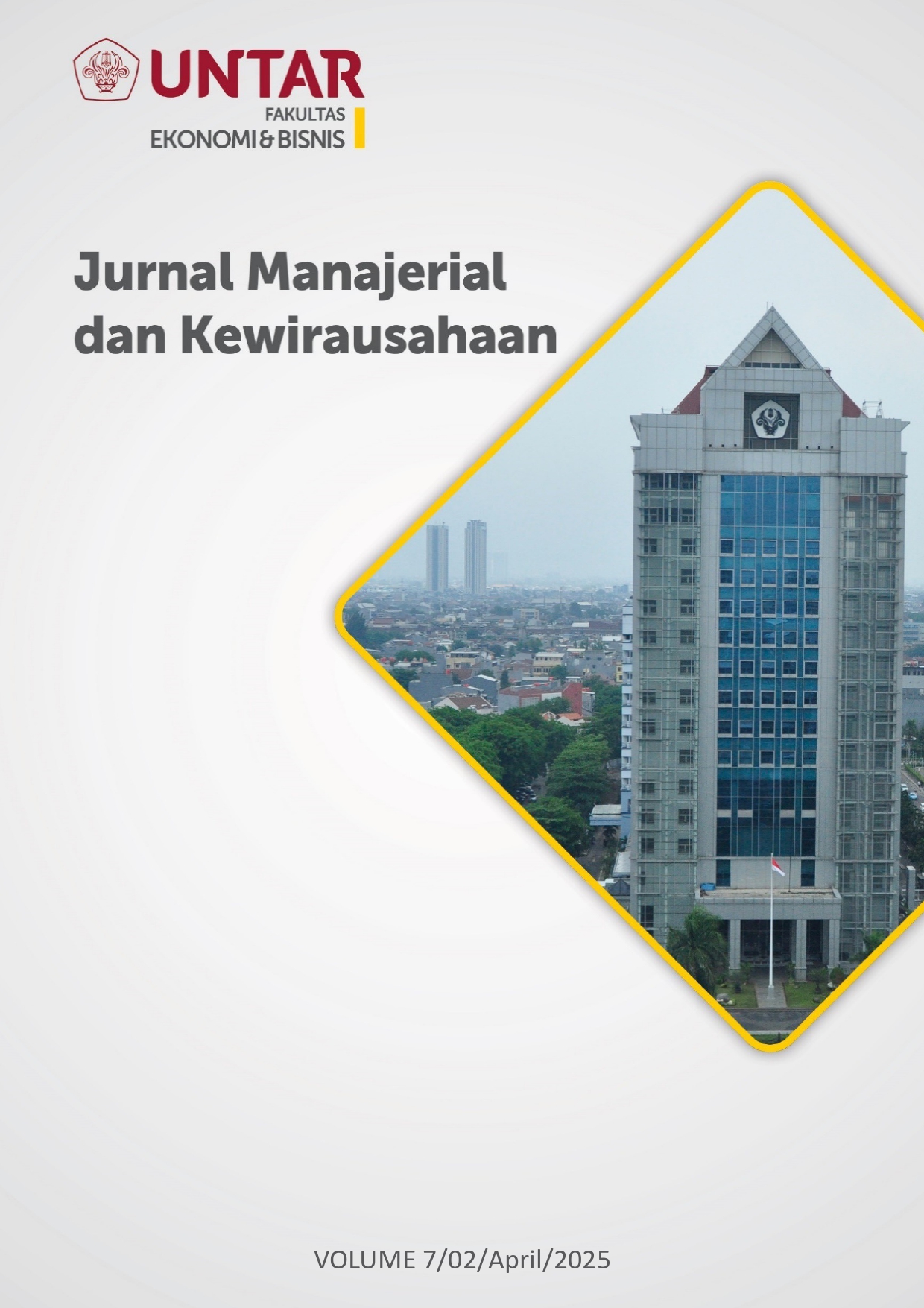Faktor-Faktor Penentu Niat Membeli Online Konsumen E-Commerce Bukalapak di Jakarta
Main Article Content
Abstract
This study aims to examine the effect of utilitarian motivation, hedonism motivation, and perceived ease of use on purchase intention. The sample used of 203 Bukalapak e-commerce users in Jakarta. Purposive sampling method was used by distributing questionnaires, which were then processed using PLS-SEM. The results of this study are utilitarian motivation, hedonism motivation, and perceived ease of use can affect purchase intention.
Article Details

This work is licensed under a Creative Commons Attribution-NonCommercial-ShareAlike 4.0 International License.
This work is licensed under a Jurnal Muara Ilmu Ekonomi dan Bisnis Creative Commons Attribution-ShareAlike 4.0 International License.,/p>
References
Aiolfi, S. (2023). How shopping habits change with artificial intelligence: smart speakers’ usage intention. International Journal of Retail & Distribution Management, 51(9/10), 1288-1312. https://doi.org/10.1108/IJRDM-11-2022-0441
Alexandra, K., & Ruslim, T. S. (2023). Factors that affect continuance usage intention of e-wallet users in Jakarta. International Journal of Application on Economics and Business, 1(1), 445-454. https://doi.org/10.24912/ijaeb.11.445-454
Bringula, R. P., Moraga, S. D., Catacutan, A. E., Jamis, M. N., & Mangao, D. F. (2018). Factors influencing online purchase intention of smartphones: a hierarchical regression analysis. Cogent Bus Manag, 5(1), 1-18. https://doi.org/10.1080/23311975.2018.1496612
Canio, D. F., Blasco. F. M., & Martinelli, E. (2023). Exploring channel switching in the aftermath of the Covid-19 pandemic: Are shoppers all driven by the same motivations?. International Journal of Retail & Distribution Management, Vol. ahead-of-print No. ahead-of-print.
Fard, S. S., Alkelani, M. A., & Tamam, E. (2019). Habit as a moderator of the association of utilitarian motivation and hedonic motivation with purchase intention: Implications for social networking websites. Cogent Social Sciences, 5(1), 1-18.
Hair, J. F., Hult, G. T., Ringle, C., & Marko, S. (2022). Partial Least Squares Structural Equation Modeling (PLS-SEM) (Third Ed.). SAGE Publications, Inc.
Herzallah, D., Leiva, M. F., & Cabanillas, L. F. (2022). Drivers of purchase intention in Instagram Commerce. Spanish Journal of Marketing - ESIC, 26(2), 168-188.
Indrawati, I., Ramantoko, G., Widarmanti, T., Aziz, A. I., & Khan, U. F. (2022). Utilitarian, hedonic, and self-esteem motives in online shopping. Spanish Journal of Marketing, 26(2), 231-246.
Jain, S. (2020). Examining the moderating role of perceived risk and web atmospherics in online luxury purchase intention, Journal of Fashion Marketing and Management: An International Journal, 25(1), 585-605.
Koch, J., Frommeyer, B., & Schewe, G. (2020). Online shopping motives during the Covid-19 pandemic—lessons from the crisis. Sustainability, 12(24), 1-20.
Lee, A., & Fiore, M. A. (2023). Factors affecting social media usage by market mavens for fashion-related information provision. Journal of Fashion Marketing and Management: An International Journal, Vol. ahead-of-print No. ahead-of-print.
Liu, C., Bao, Z., & Zheng, C. (2018). Exploring consumers’ purchase intention in social commerce An empirical study based on trust, argument quality, and social presence. Asia Pacific Journal of Marketing and Logistics, 31(2), 378-397. –18.
Malhotra, N. K. (2020). Marketing research. In The Marketing Book (7th ed.). Pearson Education Limited.
Mondal, S., & Hasan, A. A. (2023). Online grocery shopping intentions online grocery shopping in the post COVID-19 context: a case of millennial generations in Bangladesh. South Asian Journal of Marketing, Vol. ahead-of-print No. ahead-of-print.
Moslehpour, M., Pham, K. V., Wong, K. W., & Bilgicli, I. (2018). E-purchase intention of Taiwanese consumers: sustainable mediation of perceived usefulness and perceived ease of use. Sustainability, 10(1), 2-17.
N’da, K., Ge, J., Ren, F. J. S., & Wang, J. (2023) Perception of the purchase budget (BGT) and purchase intention in smartphone selling industry: A cross-country analysis. PLoS ONE, 18(7), 1-27.
Nguyen, V. H., Tran, X. H., Huy, V. L., Nguyen, N. X., Do. T. M., & Nguyen, N. (2020). Online book shopping in Vietnam: the impact of the covid-19 pandemic situation. Publishing Research Quarterly 36, 437-445.
Park, Y. D., & Kim, H. (2023). Determinants of intentions to use digital mental healthcare content among university students, faculty, and staff: motivation, perceived usefulness, perceived ease of use, and parasocial interaction with AI chatbot. Sustainability, 15(1), 1-17.
Perdana, K. J., & Tjokrosaputro, M. (2023). Factors affecting players to buy virtual items in online games. International Journal of Application on Economics and Business, 1(1), 547-558. https://doi.org/10.24912/ijaeb.11.548-558
Santo, E. P., Marques, A. M. A. (2022). Determinants of the online purchase intention: hedonic motivations, prices, information and trust. Baltic Journal of Management, 17(1), 56-71.
Sherina, A. S., & Selamat, F. (2023). The impact of consumer ethnocentrism, perceived quality, and emotional value on purchase intention of local brand streetwear products in generation Z in Jakarta. International Journal of Application on Economics and Business, 1(1), 530-538. http://dx.doi.org/10.24912/ijaeb.11.530-538
Singh, A., & Kumar, A. (2021). Designing the marketspace for millennials: fun, functionality or risk?. Journal of Marketing Analytics 9, 311-327.
Sugiyono. (2022). Metode Penelitiann Kuantitatif, Kualitatif dan RNB (2nd ed.). Alfabeta.
Tan, L. K., Hii, H. S. I., Zhu, W., Leong, M. C., & Lin, E. (2022). The borders are re-opening! Has virtual reality been a friend or a foe to the tourism industry so far?. Asia Pacific Journal of Marketing and Logistics, 35(7), 1639-1662.
Yenita, Y., Dewi, F. I. R., & Devotyasto, M. (2023). Hedonism lifestyle on the behavior of visiting tourism objects during the covid-19 pandemic. International Journal of Application on Economics and Business, 1(1), 726-732. https://doi.org/10.24912/ijaeb.v1i1.726-732
Zhang, J., & Zhang, L. (2022). Value drivers of government issued mobile coupons usage. Industrial Management & Data Systems, 122(3), 702-728.



